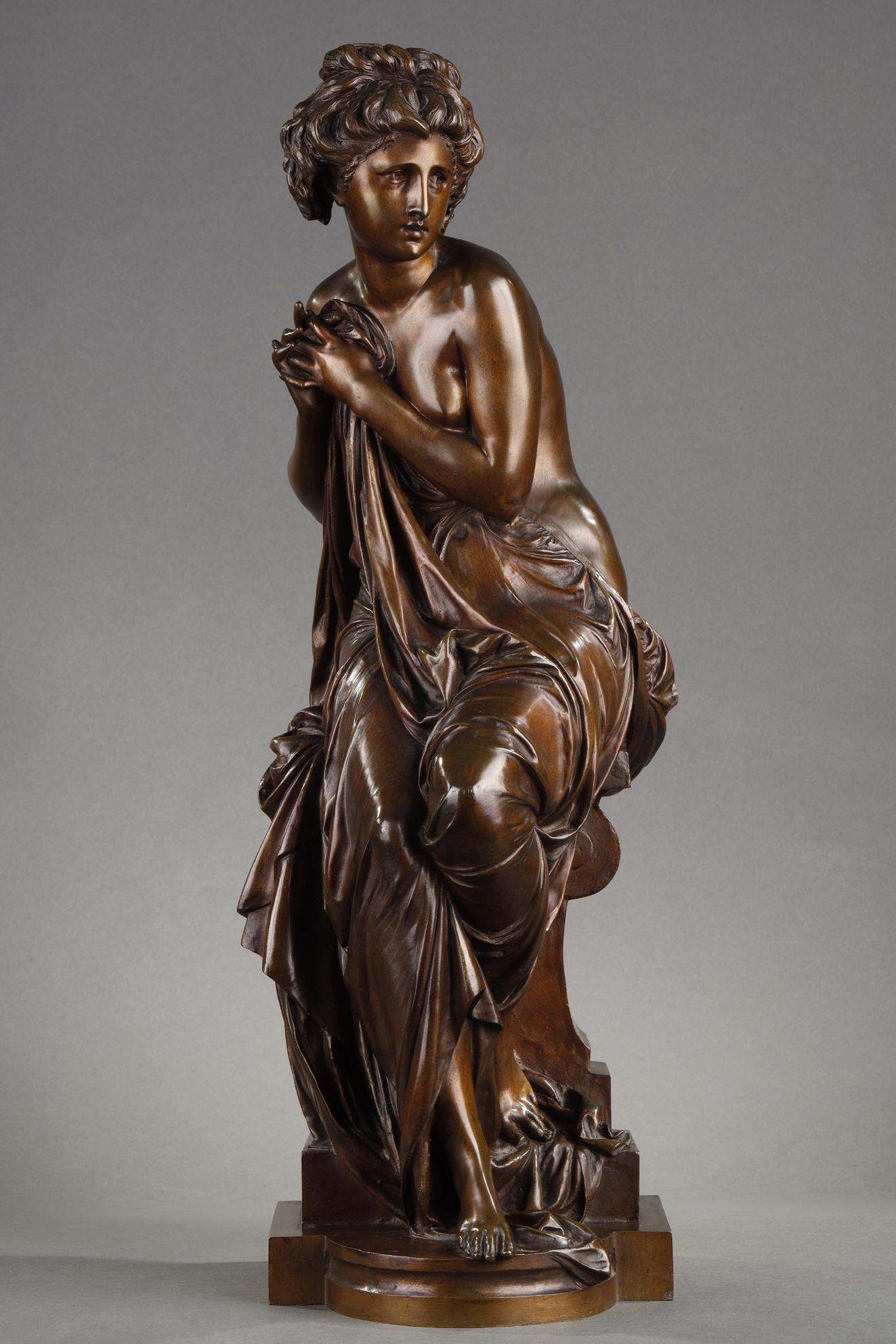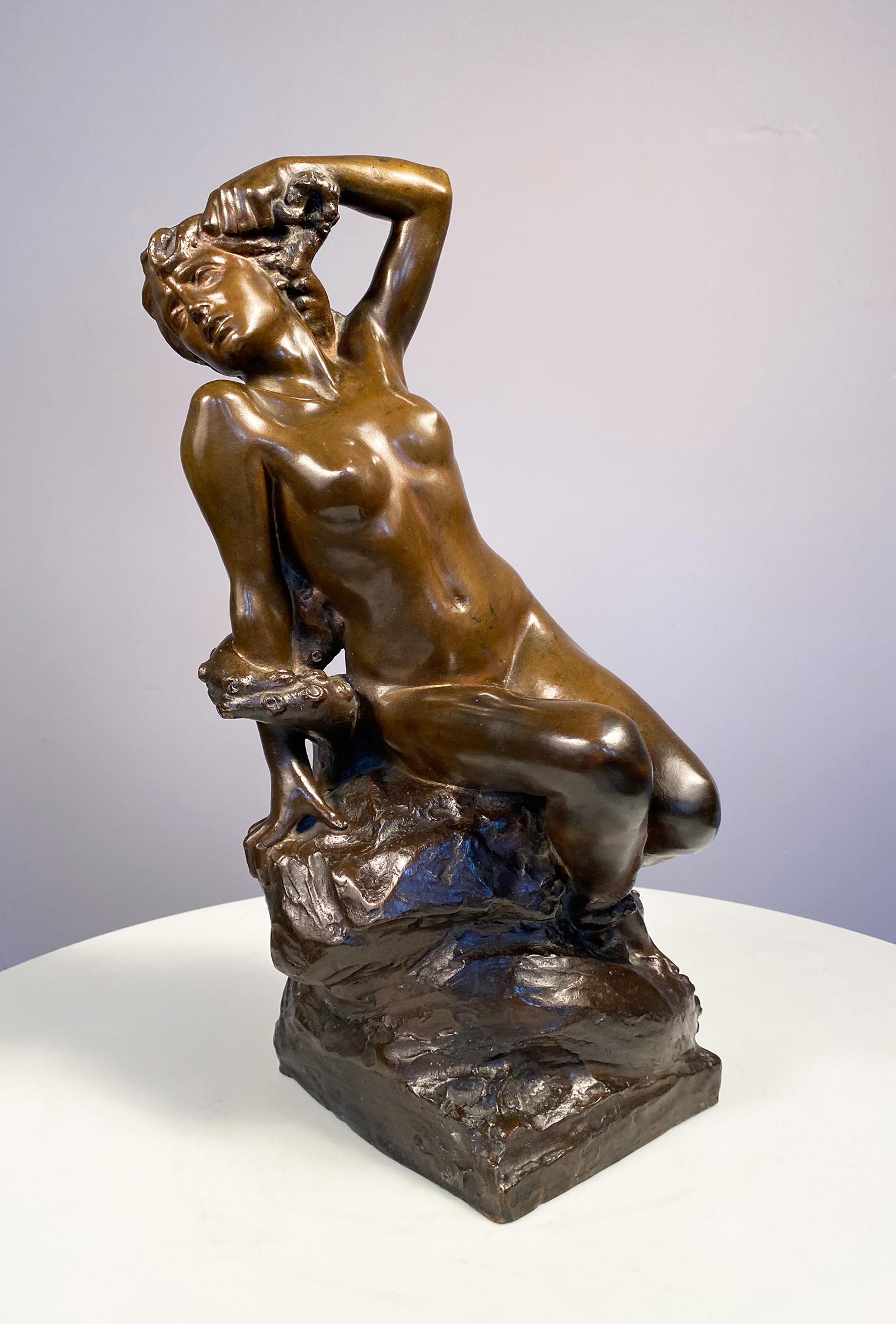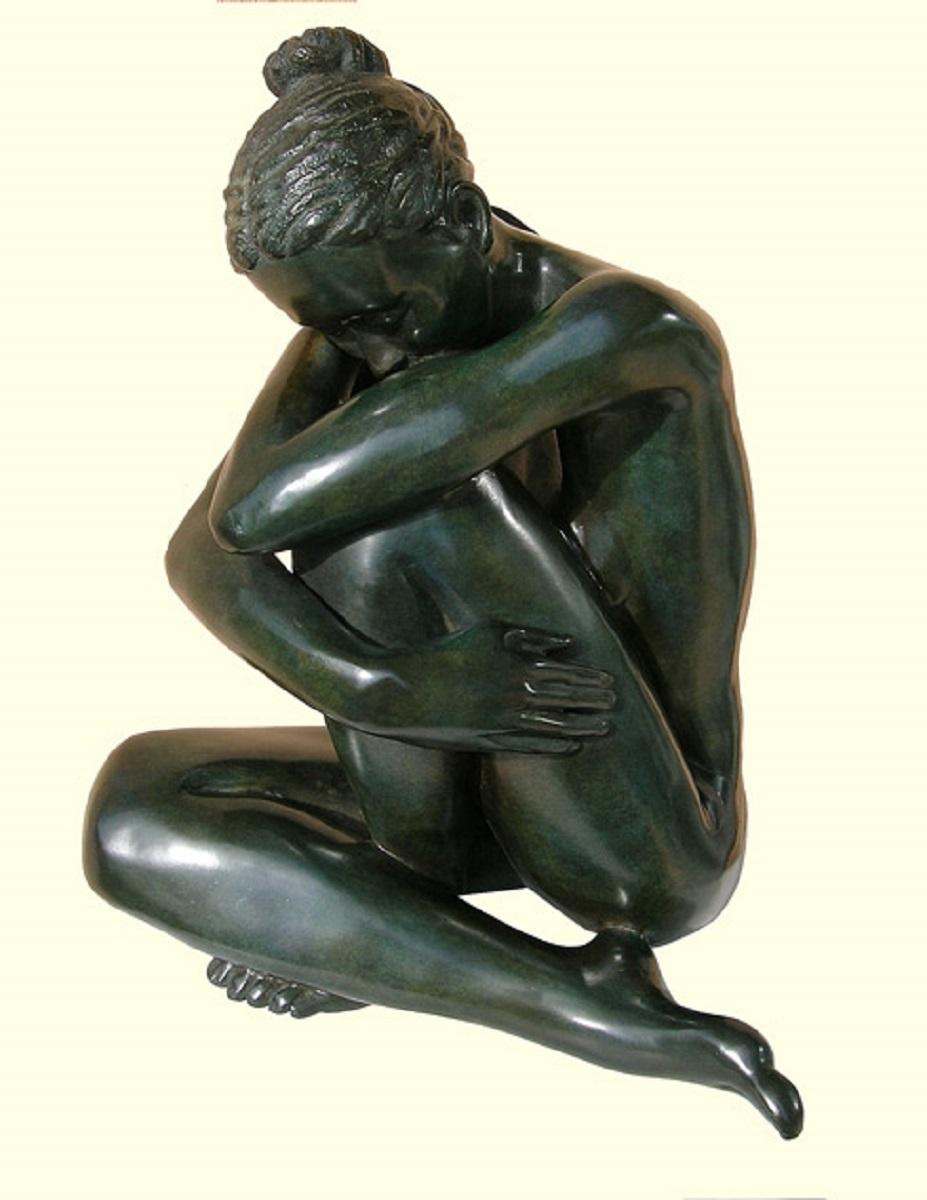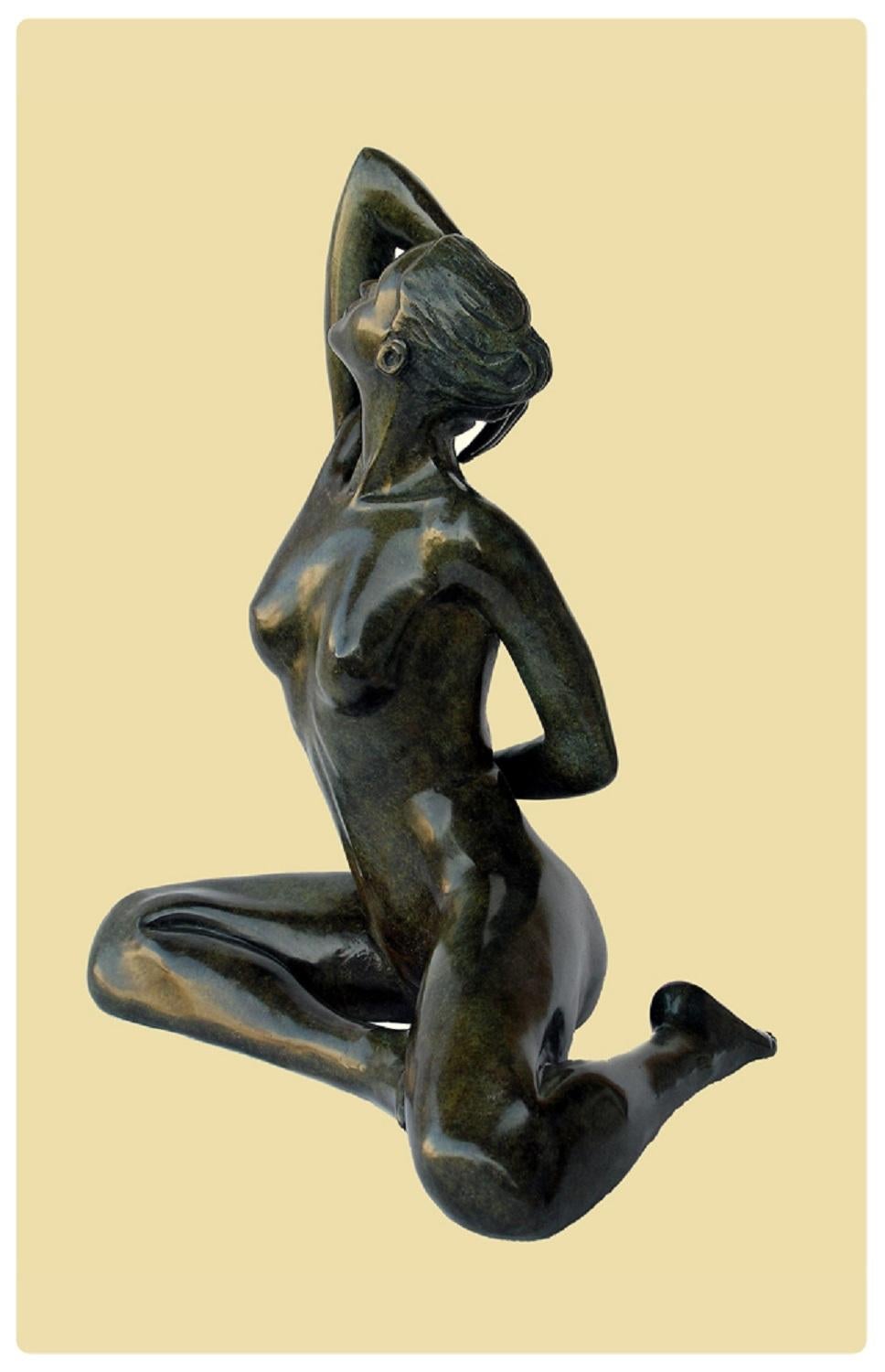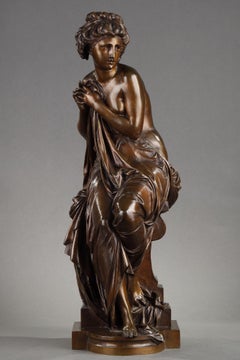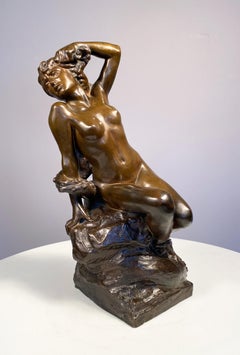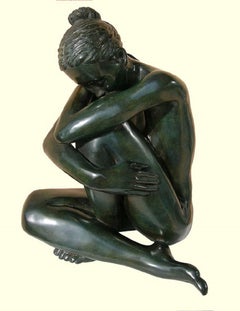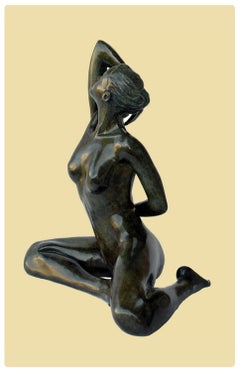Want more images or videos?
Request additional images or videos from the seller
1 of 14
Aimé-Jules DalouSuzannecirca 1880
circa 1880
$44,368.56
£33,543.78
€37,500
CA$62,038.02
A$67,800.35
CHF 35,678.71
MX$812,079.96
NOK 449,052.26
SEK 419,397.34
DKK 285,692.56
About the Item
Bathing woman drying her right foot
also known as "Suzanne"
by Aimé-Jules DALOU (1838-1902)
A bronze sculpture with a nuanced dark brown patina
Signed on the base " Dalou "
A very fine cast by " A.A. Hébrard " (with the foundry stamp)
Presented on its original beige marble base
France
posthumous cast around 1905
The casts by Hébrard are always the finest ones regarding Dalou's works. Perfect in quality of cast and patina.
height of the bronze 34,5 cm
total height 44,5 cm
width of the base 27 cm
depth 26,7 cm
A similar model reproduced in "Jules Dalou, le sculpteur de la République", Exhibition held at the Musée du Petit Palais, Paris, 2013, page 385, n°313.
Biography :
Aimé-Jules Dalou, said Jules Dalou (1838-1902) was a French sculptor, born from Protestants glovers craftsmen who raised in secularism and love of the Republic. Jules Dalou was very young talented for modeling and drawing, which earned him the attention of Jean-Baptiste Carpeaux, who made him entered in 1852 in the Little School, the future National School of Decorative Arts in Paris. In 1854, he was admitted to the School of Fine Arts in Paris, where he studied painting in the workshop of Abel de Pujol and sculpture in the workshop of Francisque Duret. He began to earn his living by working for decorators, and began his friendship with Auguste Rodin. Dalou then produced decorative sculptures for buildings on major Parisian avenues, such as the Hotel de la Paiva, on the Champs-Elysees Avenue. He presented but failed four times to Rome prize competition, but exhibited at the 1869 Salon his "Daphnis and Chloe" and the "Embroiderer" at the Salon of 1870, two pieces acquired by the French state. Dalou had one child, Georgette, a girl born with a mental handicap. This is to ensure funding for her daughter's life accommodation in the Orphanage of Arts, that Dalou bequeathed the funds from his workshop to this institution.
After the bloody week of May 1871 Dalou, his wife and their daughter were threatened as Communards, forced into exile and requested asylum. They then joined England and were greeted by his former fellows of the Little School, the painter Alphonse Legros. With Legros, much introduced in the City, he made a serie of terracotta statuettes inspired by boulonnaise peasants or intimate subjects (readers, lullabies), and portraits of the English aristocracy. He became professor for modeling at the National Art Training School, his influence was decisive for many British sculptors. He received orders for a public fountain in marble titled "Charity" (1877) near the Royal Exchange in London, and a monument dedicated to Queen Victoria's grandchildren located in the private chapel of Frogmore at Windsor Castle.
In May 1874, the Paris War Council condemned Dalou in absentia to hard labor for life. Having refused to beg for mercy, he was only in May 1879 being granted amnesty and his family finally returned from exile. His group "The Triumph of the Republic", originally planned for the Place de la Republique in Paris, was finally erected on the Place du Trône, renamed Place de La Nation in 1880. Dalou devoted twenty years to the realization of this monument. The years 1881 and 1882 were difficult, but the 1883 Salon finally revealed him to the French public. He exhibited his two high reliefs: "The Brotherhood of Peoples" and "Mirabeau answering Dreux-Brézé", for which he was awarded the Medal of Honor. Fleeing the world and living in family, Dalou engaged in considerable work and many orders both private and public. For the Universal Exhibition of 1889, was inaugurated on the Place de la Nation the plaster of "The Triumph of the Republic" commissioned by the city of Paris in 1879. Although the bronze version of the group was inaugurated in 1899, this work won the grand prize for sculpture in the exhibition. Dalou left the French Society of Artists in 1890 to expose at the National Society of Fine Arts, of which he was a founding member with Ernest Meissonier, Auguste Rodin and Pierre Puvis de Chavannes. Awarded Knight of the Legion of Honor in 1883, and promoted to officer by President Carnot in 1889, he was elevated to the rank of Commander of the same order in 1899 by President Loubet at the inauguration of the monument of "The Triumph of the Republic".
Dalou had no time to complete his last great project, a monument dedicated to workers, the idea came to him in 1889 after the first opening of "TheTriumph of the Republic". The formality of the ceremony and military parades held the people away from the official event. Dalou was disappointed. True to its republican ideals, he had hoped that this inauguration was an opportunity of great popular democratic party (as it was at the inauguration of the bronze in 1899). His idea was then to pay tribute to the world of workers, craftsmen and peasants with this work being the central subject. At the end of his career Dalou described the project as follows: "I think I have finally found the monument to the workers that I seek since 1889. Sober, without molding or ornament, I wish it'd be severe and imposing. Will I execute it? There is the question. I am old and my health is so weak."
- Creator:Aimé-Jules Dalou (1838 - 1902, French)
- Creation Year:circa 1880
- Dimensions:Height: 17.52 in (44.5 cm)Width: 10.63 in (27 cm)Depth: 10.52 in (26.7 cm)
- Medium:
- Movement & Style:
- Period:
- Condition:
- Gallery Location:PARIS, FR
- Reference Number:Seller: N.76281stDibs: LU2514216551482
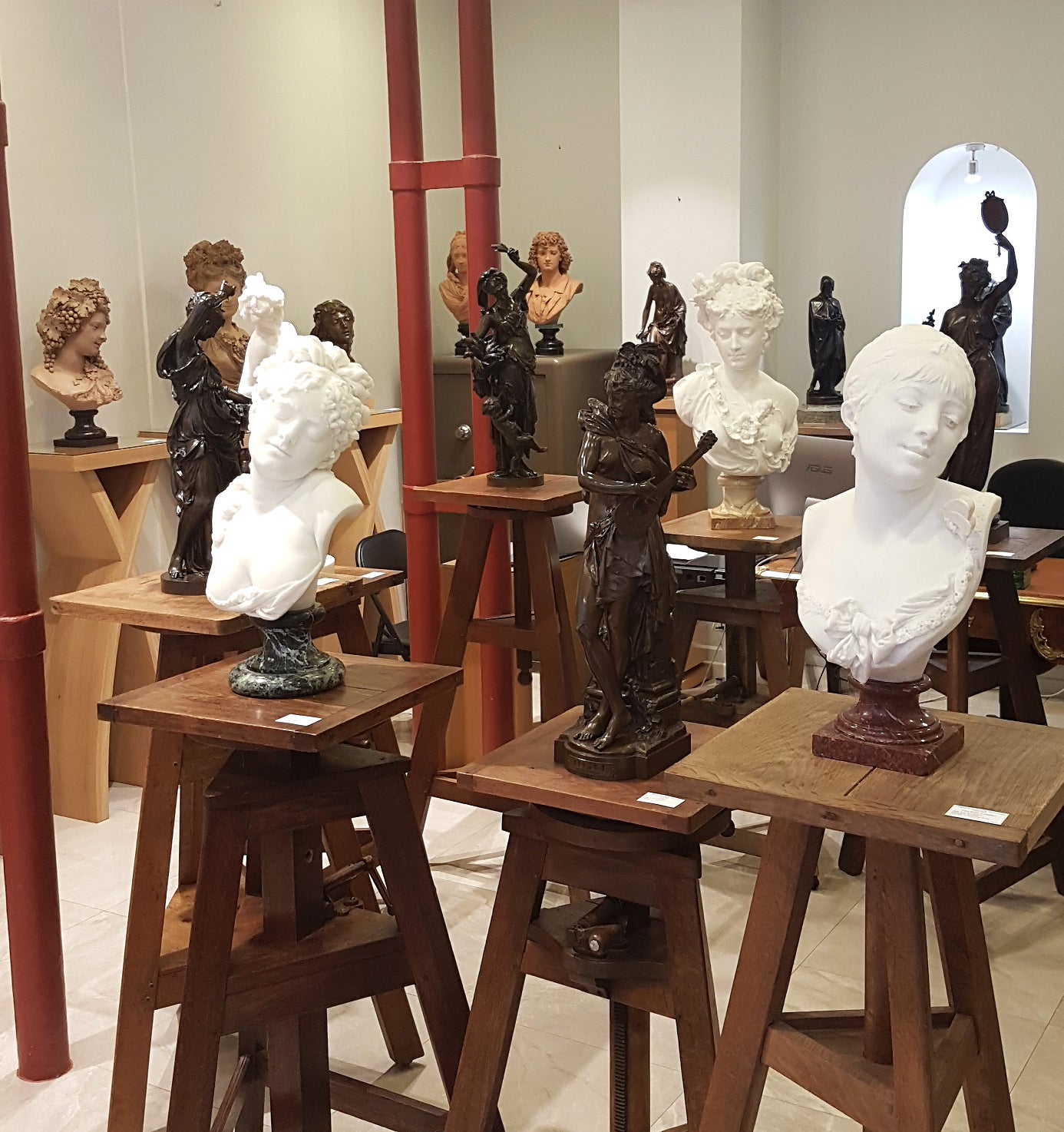
About the Seller
5.0
Recognized Seller
These prestigious sellers are industry leaders and represent the highest echelon for item quality and design.
Established in 1992
1stDibs seller since 2023
11 sales on 1stDibs
Typical response time: 12 hours
- ShippingRetrieving quote...Shipping from: PARIS, France
- Return Policy
More From This Seller
View AllDesperate
By Aimé-Jules Dalou
Located in PARIS, FR
Desperate
by Jules DALOU (1838-1902)
A bronze sculpture with a nuanced dark brownish-green patina
Signed on the base " Dalou "
Cast by " Susse Frères Editeurs Paris " (with the fou...
Category
Late 19th Century French School Nude Sculptures
Materials
Bronze
$10,648
Susanna
By Albert-Ernest Carrier-Belleuse
Located in PARIS, FR
Susanna
by Albert-Ernest Carrier-Belleuse (1824-1887)
Bronze sculpture with nuanced brown patina
signed to the side " A. Carrier "
old period cast
France
circa 1860
height 62 cm
...
Category
1860s French School Figurative Sculptures
Materials
Bronze
Purity
By Joseph Bernard
Located in PARIS, FR
"Purity"
also known as "Bust of a young girl"
by Joseph BERNARD (1866-1931)
Bust in bronze with a nuanced dark brown patina
Signed “ J Bernard ” and marked “ N 3 ”
Sand cast
Cast by the artist
Raised on a wooden base
France
circa 1910
height of the bronze : 24 cm
total height with its base : 29 cm
width : 22,5 cm
depth : 13,5 cm
The model of this head is a study made for the pink marble bust...
Category
Early 20th Century French School Figurative Sculptures
Materials
Bronze
Symbole
Located in PARIS, FR
Horse "Symbole"
by René PARIS (1881-1970)
Animal sculpture in bronze with a nuanced light brown patina
signed on the base "René Paris"
and dated "1942"
Cast by "A. Valsuani" (with f...
Category
1940s French School Figurative Sculptures
Materials
Bronze
$10,648
The Comedy
Located in PARIS, FR
Pierre-Marie POISSON (1876-1953)
The Comedy
Bronze sculpture with black patina
signed on the base "P. Poisson"
Cast by Valsuani (with the foundry stamp)
Raised on a stone base
Fra...
Category
1930s French School Figurative Sculptures
Materials
Bronze
Paver
By Aimé-Jules Dalou
Located in PARIS, FR
This paver is a subject that is included in the famous suite commonly called "little workers" by Jules Dalou (1838-1902)
Bronze with dark brown patina
cast by Susse Frères - stamped...
Category
Late 19th Century French School Figurative Sculptures
Materials
Bronze
You May Also Like
Pathos
Located in New York, NY
A sensuous and fabulous piece to enjoy in the round as every vantage point is attractive or on a shelf or table.
In the 19th century, the Italians and French were in a golden era f...
Category
1890s Academic Figurative Sculptures
Materials
Bronze
Sabrina
By Patrick Brun
Located in Pasadena, CA
Patrick BRUN was born in Paris in 1941. After obtaining his Engineering degree, he began his professional life as a teacher in mathematics and physics. After this period, he started ...
Category
2010s Contemporary Figurative Sculptures
Materials
Bronze
$5,200 Sale Price
31% Off
Agosta
By Patrick Brun
Located in Pasadena, CA
Patrick BRUN was born in Paris in 1941. After obtaining his Engineering degree, he began his professional life as a teacher in mathematics and physics. After this period, he started ...
Category
2010s Contemporary Figurative Sculptures
Materials
Bronze
$3,840 Sale Price
32% Off
La Fileuse
By Albert-Ernest Carrier-Belleuse
Located in London, GB
signed 'A. CARRIER-BELLEUSE' (on base)
Category
Mid-19th Century Figurative Sculptures
Materials
Bronze
Europe
Located in PARIS, FR
Boldi is a Hungarian sculptor who creates works that express a balance between reason and emotion. His sculptures reveal not only the true form of human figures but also the emotions...
Category
2010s Contemporary Figurative Sculptures
Materials
Bronze
$130,147
Amandine Bronze Sculpture
By Ybah
Located in Pasadena, CA
After studying fine arts, a need for contact with solid material was needed. Ybah took a classic artistic path from an academic education from the Louvre reproductions, learning at t...
Category
21st Century and Contemporary Modern Figurative Sculptures
Materials
Bronze
More Ways To Browse
Jean Baptiste Carpeaux
Giacometti Kiss
Gillie And Marc Hippo Bronze
Gillie And Marc Hippo
Gillie And Marc Rhino
Giuseppe Armani Disney
Gorilla Buddha
Harriet Lewis
Harris Deller Teapot
Harry Jackson Bronze
Harry Marinsky Bronze
Hippo Rope
Icart Bronze
Irma Starr On Sale
Irma Starr
Isaac Maimon Sculpture
Jane Rosen Birds
Japanese Bronze One Of Four Ryusen
